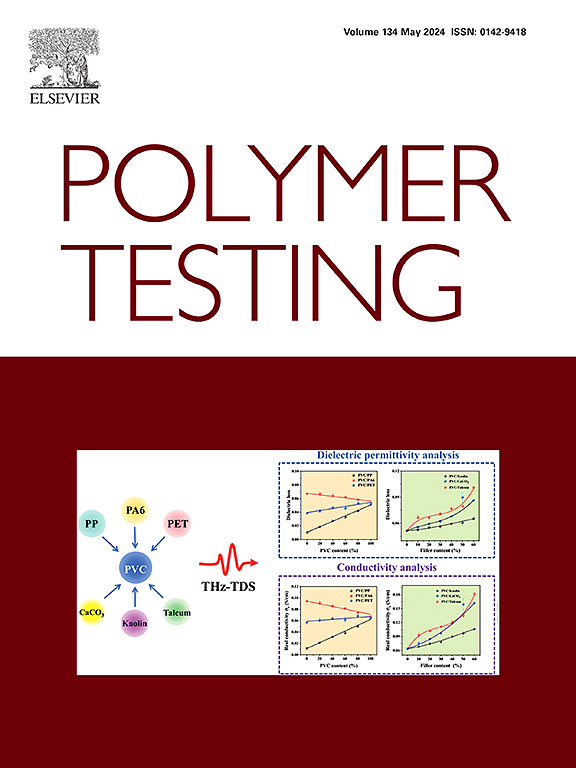Complex cure kinetics of self-healing copolyester vitrimers via isothermal thermogravimetric analysis
IF 5
2区 材料科学
Q1 MATERIALS SCIENCE, CHARACTERIZATION & TESTING
引用次数: 0
Abstract
Thermogravimetric Analysis (TGA) is a valuable tool for studying chemical reactions that release volatile compounds. Constant-temperature TGA can be particularly useful for polymer cure reactions with complex, time-evolving phenomenology, by ensuring time and temperature effects remain separable. In this work, a compound isothermal TGA methodology is developed to study the cure process of high-performance vitrimers known as Aromatic Thermosetting coPolyesters (ATSP). By fitting observed mass loss to a nondimensional phenomenological model with generalized terms and introducing additional nonphysical terms to account both known and suspected non-cure behaviors, changes in cure kinetics were evaluated across a wide range of temperatures (210°C–380 °C). The activation of the added nonphysical terms was used to differentiate between expected cure behavior (240°C–340 °C), and cures involving precursor decomposition (>340 °C). An unexpected cure-like reaction below cure temperature (<240 °C) was hypothesized to correspond to self-healing bond exchange, which is well-understood to cause changes in molecular weight in thermoplastic polyesters. This was directly validated via evolved gas analysis, and activation energies were calculated for the cure-dominant region of the reaction. These activation energies were found to be similar across different polymer formulations. When combined with significant observed mass loss below the expected cure temperature and findings in prior work, this indicates that the apparent cure process may be driven by thermodynamically-favorable bond exchange reactions.
用等温热重法分析自愈共聚酯玻璃体的复固化动力学
热重分析(TGA)是研究挥发性化合物释放化学反应的重要工具。通过确保时间和温度效应保持可分离,恒温热重分析对于具有复杂的、随时间变化的现象的聚合物固化反应特别有用。在这项工作中,开发了一种复合等温热重分析方法来研究高性能玻璃聚合物芳香热固性共聚酯(ATSP)的固化过程。通过将观察到的质量损失拟合到具有广义项的无维现象学模型中,并引入额外的非物理项来解释已知和可疑的非固化行为,在广泛的温度范围内(210°C - 380°C)评估了固化动力学的变化。添加的非物理项的活化被用来区分预期的固化行为(240°C - 340°C)和涉及前驱体分解的固化(>340°C)。假设在固化温度(<240°C)以下发生了意想不到的类似固化的反应,与自愈键交换相对应,这是众所周知的导致热塑性聚酯分子量变化的原因。通过演化气体分析直接验证了这一点,并计算了反应的固化优势区域的活化能。发现这些活化能在不同的聚合物配方中是相似的。结合观察到的低于预期固化温度的显著质量损失和先前工作的发现,这表明表面的固化过程可能是由热力学上有利的键交换反应驱动的。
本文章由计算机程序翻译,如有差异,请以英文原文为准。
求助全文
约1分钟内获得全文
求助全文
来源期刊

Polymer Testing
工程技术-材料科学:表征与测试
CiteScore
10.70
自引率
5.90%
发文量
328
审稿时长
44 days
期刊介绍:
Polymer Testing focuses on the testing, analysis and characterization of polymer materials, including both synthetic and natural or biobased polymers. Novel testing methods and the testing of novel polymeric materials in bulk, solution and dispersion is covered. In addition, we welcome the submission of the testing of polymeric materials for a wide range of applications and industrial products as well as nanoscale characterization.
The scope includes but is not limited to the following main topics:
Novel testing methods and Chemical analysis
• mechanical, thermal, electrical, chemical, imaging, spectroscopy, scattering and rheology
Physical properties and behaviour of novel polymer systems
• nanoscale properties, morphology, transport properties
Degradation and recycling of polymeric materials when combined with novel testing or characterization methods
• degradation, biodegradation, ageing and fire retardancy
Modelling and Simulation work will be only considered when it is linked to new or previously published experimental results.
 求助内容:
求助内容: 应助结果提醒方式:
应助结果提醒方式:


